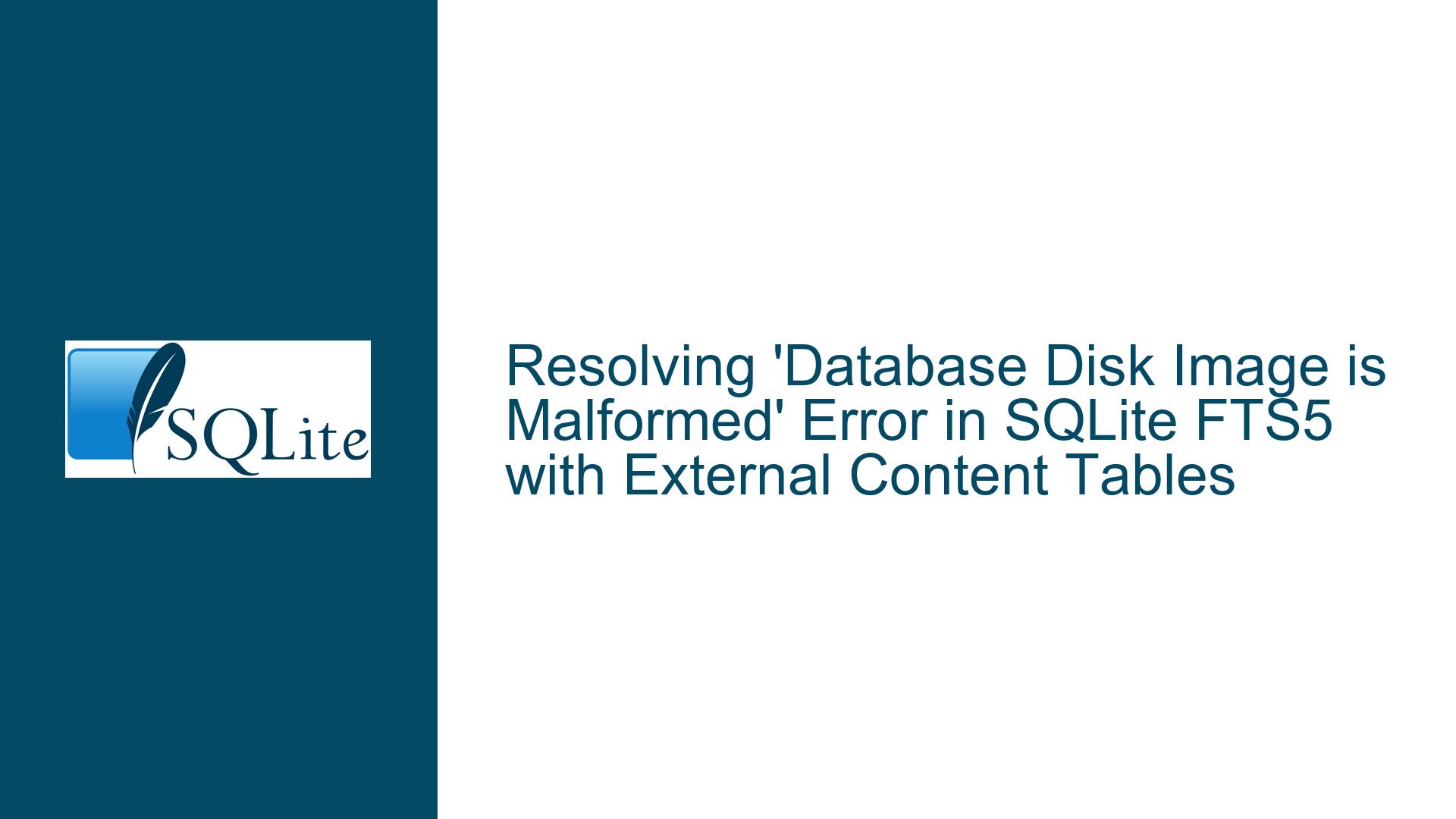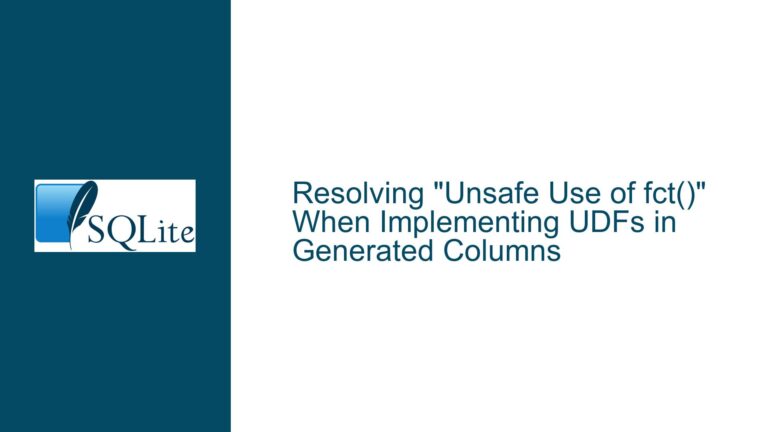Resolving ‘Database Disk Image is Malformed’ Error in SQLite FTS5 with External Content Tables
Issue Overview: FTS5 External Content Table Misconfiguration Leading to Malformed Database
The core issue revolves around the misuse of SQLite’s FTS5 (Full-Text Search) virtual table in conjunction with an external content table. The error message "database disk image is malformed" is a critical indicator of database corruption or misconfiguration. In this case, the misconfiguration stems from the improper use of a WITHOUT ROWID table as the external content table for an FTS5 virtual table.
The FTS5 virtual table is designed to work seamlessly with external content tables, which are standard SQLite tables that store the actual data being indexed. However, FTS5 imposes specific requirements on these external content tables, particularly regarding the structure and the presence of a ROWID. The ROWID is an internal SQLite identifier that is essential for FTS5 to maintain the relationship between the indexed content and the external data. When these requirements are not met, the database can become malformed, leading to errors during operations such as integrity checks or query execution.
In the provided scenario, the meta table was defined as a WITHOUT ROWID table, which inherently lacks the ROWID that FTS5 relies on. This misalignment between the FTS5 configuration and the external content table’s structure caused the database to become malformed, triggering the error. The issue was further compounded by the use of a TEXT PRIMARY KEY column (path) as the content_rowid in the FTS5 configuration, which is incompatible with FTS5’s requirement for an INTEGER PRIMARY KEY.
Possible Causes: Misalignment Between FTS5 Requirements and External Content Table Structure
The primary cause of the "database disk image is malformed" error in this context is the misalignment between the FTS5 virtual table’s requirements and the structure of the external content table. Specifically, the following factors contributed to the issue:
Use of a
WITHOUT ROWIDTable as an External Content Table: Themetatable was defined with theWITHOUT ROWIDclause, which eliminates the implicitROWIDcolumn that SQLite typically assigns to each table. FTS5 relies on thisROWIDto maintain the relationship between the indexed content and the external data. Without aROWID, FTS5 cannot properly index or reference the data in the external content table, leading to corruption.Incorrect
content_rowidSpecification: The FTS5 configuration specifiedcontent_rowid=path, wherepathis aTEXT PRIMARY KEYcolumn. FTS5 requires thecontent_rowidto reference anINTEGER PRIMARY KEYcolumn, as this column serves as the unique identifier for each row in the external content table. Using aTEXTcolumn for this purpose violates FTS5’s requirements and disrupts the indexing process.Trigger Logic Assuming a Valid FTS5 Configuration: The triggers defined on the
metatable (meta_ai,meta_ad, andmeta_au) were designed to synchronize data between themetatable and the FTS5searchtable. However, these triggers assumed that the FTS5 configuration was valid and that thesearchtable could correctly reference themetatable. When the FTS5 configuration was invalid due to theWITHOUT ROWIDand incorrectcontent_rowidsettings, the triggers attempted to perform operations on a malformed database, exacerbating the issue.Lack of Immediate Error Detection: The error was not immediately apparent during the initial setup or data insertion. Instead, it manifested during an integrity check or query execution, making it more challenging to diagnose. This delayed detection allowed the malformed state to persist, increasing the risk of further corruption.
Troubleshooting Steps, Solutions & Fixes: Correcting FTS5 Configuration and Restoring Database Integrity
To resolve the "database disk image is malformed" error and ensure the proper functioning of the FTS5 virtual table with an external content table, follow these detailed troubleshooting steps and solutions:
Remove the
WITHOUT ROWIDClause from the External Content Table: The first step is to modify themetatable to include aROWID. This can be achieved by removing theWITHOUT ROWIDclause from the table definition. The updatedmetatable definition should look like this:CREATE TABLE IF NOT EXISTS meta ( path TEXT PRIMARY KEY NOT NULL, artist TEXT, title TEXT );This change ensures that the
metatable includes an implicitROWIDcolumn, which is necessary for FTS5 to function correctly.Update the FTS5 Configuration to Use an
INTEGER PRIMARY KEY: Since FTS5 requires thecontent_rowidto reference anINTEGER PRIMARY KEYcolumn, you must either use the implicitROWIDor define an explicitINTEGER PRIMARY KEYcolumn in themetatable. If you prefer to use the implicitROWID, you can omit thecontent_rowidspecification entirely, as FTS5 will automatically use theROWID. Alternatively, if you want to use an explicit column, modify themetatable and FTS5 configuration as follows:CREATE TABLE IF NOT EXISTS meta ( id INTEGER PRIMARY KEY, path TEXT NOT NULL, artist TEXT, title TEXT ); CREATE VIRTUAL TABLE IF NOT EXISTS search USING fts5( path UNINDEXED, artist, title, content=meta, content_rowid=id );In this example, the
idcolumn serves as theINTEGER PRIMARY KEYand is referenced by thecontent_rowidparameter in the FTS5 configuration.Rebuild the FTS5 Index: After correcting the table definitions and FTS5 configuration, you must rebuild the FTS5 index to ensure that it accurately reflects the data in the
metatable. This can be done by dropping and recreating thesearchtable:DROP TABLE IF EXISTS search; CREATE VIRTUAL TABLE IF NOT EXISTS search USING fts5( path UNINDEXED, artist, title, content=meta, content_rowid=id );Rebuilding the index ensures that any corruption caused by the previous misconfiguration is eliminated.
Review and Update Trigger Logic: The triggers (
meta_ai,meta_ad, andmeta_au) must be reviewed to ensure they align with the updated table definitions and FTS5 configuration. Specifically, ensure that the triggers correctly reference theROWIDorINTEGER PRIMARY KEYcolumn when performing operations on thesearchtable. For example:CREATE TRIGGER IF NOT EXISTS meta_ai AFTER INSERT ON meta BEGIN INSERT INTO search(rowid, path, artist, title) VALUES (new.id, new.path, new.artist, new.title); END; CREATE TRIGGER IF NOT EXISTS meta_ad AFTER DELETE ON meta BEGIN INSERT INTO search(search, rowid, path, artist, title) VALUES ('delete', old.id, old.path, old.artist, old.title); END; CREATE TRIGGER IF NOT EXISTS meta_au AFTER UPDATE ON meta BEGIN INSERT INTO search(search, rowid, path, artist, title) VALUES ('delete', old.id, old.path, old.artist, old.title); INSERT INTO search(rowid, path, artist, title) VALUES (new.id, new.path, new.artist, new.title); END;These updates ensure that the triggers correctly synchronize data between the
metaandsearchtables using the appropriateROWIDorINTEGER PRIMARY KEY.Perform a Comprehensive Integrity Check: After making the necessary changes, perform a thorough integrity check on the database to verify that the malformed state has been resolved. Use the
PRAGMA integrity_checkcommand to scan the database for any remaining issues:PRAGMA integrity_check;If the integrity check passes without errors, the database is in a valid state, and the FTS5 virtual table should function correctly.
Test the FTS5 Query Functionality: Finally, test the FTS5 query functionality to ensure that the
searchtable correctly indexes and retrieves data from themetatable. Execute a sample query to verify that the FTS5 virtual table operates as expected:SELECT * FROM search WHERE search MATCH 'Test';If the query returns the expected results, the FTS5 configuration is correct, and the database is fully operational.
By following these troubleshooting steps and solutions, you can resolve the "database disk image is malformed" error and ensure the proper functioning of SQLite’s FTS5 virtual table with an external content table. This approach addresses the root causes of the issue, corrects the misconfigurations, and restores database integrity, providing a robust foundation for full-text search functionality in your application.






